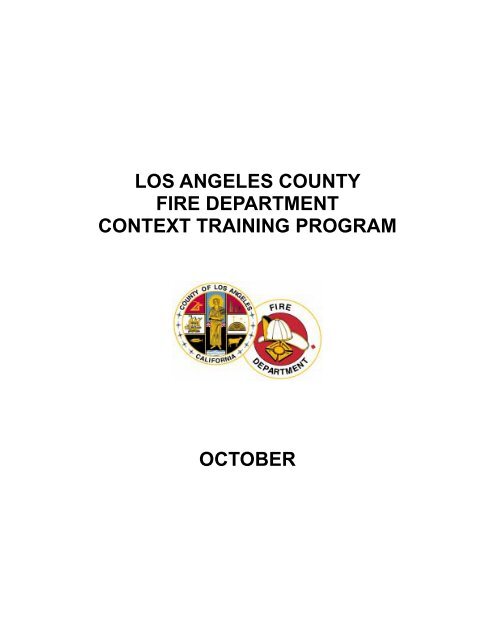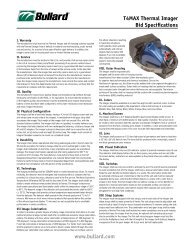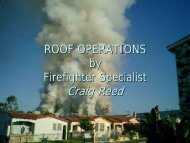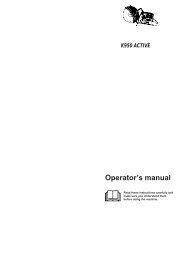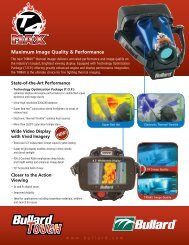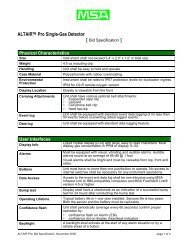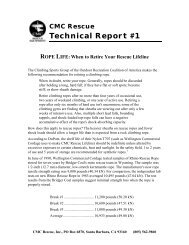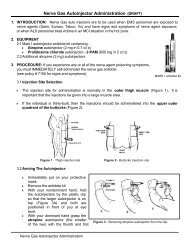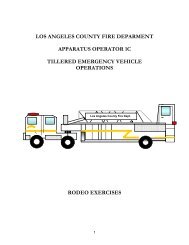Ropes & Knots.pdf - Los Angeles County Firefighters Association
Ropes & Knots.pdf - Los Angeles County Firefighters Association
Ropes & Knots.pdf - Los Angeles County Firefighters Association
Create successful ePaper yourself
Turn your PDF publications into a flip-book with our unique Google optimized e-Paper software.
LOS ANGELES COUNTY<br />
FIRE DEPARTMENT<br />
CONTEXT TRAINING PROGRAM<br />
OCTOBER
LOS ANGELES COUNTY<br />
FIRE DEPARTMENT<br />
CONTEXT TRAINING PROGRAM<br />
ROPES AND KNOTS<br />
2
3<br />
LOS ANGELES COUNTY FIRE DEPARTMENT<br />
CONTEXT TRAINING PROGRAM<br />
ROPES AND KNOTS<br />
1. General Information<br />
<strong>Ropes</strong> used by <strong>Los</strong> <strong>Angeles</strong> <strong>County</strong> Fire Department are of the Static Nylon<br />
Kernmantle design. This means that a braided sheath woven over an inner core<br />
with minimum low stretch. The inner bundles contribute most of the ropes tensile<br />
strength. They are continuous throughout the rope and run parallel, which not<br />
only reduces stretch, but also prevents spin. The load carrying core (kern) is<br />
protected from dirt, abrasion, and cutting by a tightly braided outer sheath<br />
(mantle).<br />
Rope shall be stored in the nylon rescue system packs and shall not be stored in<br />
compartments near fuel or battery storage areas. All rope and equipment shall be<br />
stored inside a compartment.<br />
2. Life Line Rope<br />
With the breaking strength at 9000 pounds, 600 pounds is the maximum<br />
allowable load (working strength) that can be placed on a single line of 1/2-inch<br />
rope (15:1 safety margin).<br />
a. Construction: Static Kern mantle<br />
Material: 100% nylon (type 6.6)<br />
b. Elongation: Less than 2% at 200 lbs.<br />
c. Heat: Melts at 480 F. Becomes sticky at 445 F. Yellows at 300 F.<br />
d. Braid: One over, one under (braid on braid) for high abrasion resistance<br />
e. Core: Continuous block creel construction, parallel nylon fiber bundles, for<br />
low stretch and no spin.<br />
f. Identification: Continuous marker in core bundles gives place, year, and<br />
quarter of manufacture.<br />
g. Service Life: Cannot be determined in advance. It depends on a number<br />
of factors such as; Proper care, frequency of use, type of decenders used,<br />
speed of decent, rock or building abrasiveness, climate, and type of<br />
loading the rope is subject to.<br />
h. Lifeline rope use: After each use, whether training or rescue, an entry<br />
shall be made on the Form 247 assigned to the lifeline.
4<br />
LOS ANGELES COUNTY FIRE DEPARTMENT<br />
CONTEXT TRAINING PROGRAM<br />
3. Equipment Line Rope<br />
ROPES AND KNOTS<br />
An assembly of 85 ft. of 3/8-inch nomial diameter braid on braid nylon rope.<br />
Continuous construction with no "braider" splices. Both ends eye spliced around<br />
zinc plated steel buckles. Drop bag shall never be used on loads over 300<br />
pounds. Life safety ropes should never be used to support live loads.<br />
a. Breaking Strength: 4,620 lbs.<br />
4. Maintenance<br />
Rope shall be inspected and inventoried monthly and noted on Form 248.<br />
Rope shall be kept as clean as possible. Under no circumstances shall rope be<br />
dragged through dirt or grime unless life safety requires such action.<br />
Rope shall be protected from abrasive particles and edges. Scuff pads, hose<br />
rollers, hose or other protective measures shall be used as needed.<br />
Life Lines shall not be used for any other purposes, such as raising or tying off<br />
equipment. In such cases, the rope shall immediately be taken out of service as<br />
a Life Line.<br />
Visually inspect and feel the entire length of rope. Be aware of brittle, broken, or<br />
melted fibers, discoloration, soft spots, inconsistencies in the diameter, spot<br />
abrasions that reveal inner core, foreign particles embedded in the outer jacket,<br />
and any other discrepancies which may harm the integrity of the rope.<br />
Washing the Static Nylon Kernmantle rope shall be performed by chain looping<br />
the entire length of rope. Machine or hand wash using Woolite or comparable<br />
mild soap, warm water, gentle cycle, hang to drip dry.<br />
NOTE:<br />
Additional information on ropes and rescue systems can be found<br />
in Volume 4, Chapter 6.
5<br />
LOS ANGELES COUNTY FIRE DEPARTMENT<br />
CONTEXT TRAINING PROGRAM<br />
5. Responsibility<br />
ROPES AND KNOTS<br />
All personnel shall be responsible for identifying the parts and procedures on<br />
tying fourteen (14) Department knots and one (1) specialized assembly.<br />
6. <strong>Knots</strong><br />
a. Slip Knot (Equipment Tie Off)<br />
b. Round turn and two half hitches (Lashing)<br />
c. Clove hitch (Equipment Tie Off)<br />
d. Larks foot/Girth hitch (Equipment Tie Off,<br />
Taut Prusik Release, Anchoring)<br />
e. Overhand Knot (Safety Tie Off)<br />
f. Double Overhand Bend (Used to form Prusik Loop)<br />
g. Prusik Hitch (Rappel Safety, Braking and<br />
Pulling Cam)<br />
h. Overhand Follow Through/Water Knot (Webbing Loops,<br />
Adjustable Harness Belt when<br />
used for anchoring Points)<br />
i. Bowline (Hose Roller, Litter Tie Off)<br />
j. Figure of Eight (Stopper Knot)<br />
k. Figure of Eight on a Bight (Basic Anchor Knot)<br />
l. Inline Figure of Eight (Modified Trucker's Hitch,<br />
Directional In-line Loop)<br />
m. Figure of Eight Follow Through (For Joining Two Lines)<br />
n. Figure of Eight Follow Through (For Anchor Pt. Tie off)
6<br />
LOS ANGELES COUNTY FIRE DEPARTMENT<br />
CONTEXT TRAINING PROGRAM<br />
7. Specialized Assembly<br />
ROPES AND KNOTS<br />
Modified Trucker's Hitch (Securing Hose Roller, Ladder Rigs, etc)<br />
Mariner’s Knot<br />
8. Tying Off Equipment<br />
All Personnel shall be responsible for safely tying off the following equipment:<br />
a. Axe/Sledge Hammer<br />
b. Cylindrical Object<br />
c. Hand Line<br />
d. Hose Roller<br />
e. Ladder<br />
f. Long Handled Tools: Straight/"D" handled<br />
g. Rectangle Object<br />
h. Chain/Rotary Saw<br />
i. Stokes Stretcher with a Spider<br />
1. Vertical 2. Horizontal<br />
9. Securing Ground Ladder<br />
It is the policy of the Department that the first person to climb a ground ladder<br />
shall secure it to the structure. Personnel are to accomplish this by using a<br />
combination hose/ladder strap, which is acquired as personal issue and is to be<br />
carried in the turnout jacket. This strap consists of a metal hook having a<br />
two-inch opening at one end and a one-inch by seven-foot continuous nylon<br />
webbing at the other end.
7<br />
LOS ANGELES COUNTY FIRE DEPARTMENT<br />
CONTEXT TRAINING PROGRAM<br />
9. Securing Ground Ladder (cont)<br />
ROPES AND KNOTS<br />
To secure the top of the ladder to the structure, the following method shall be<br />
used:<br />
a. Secure the opening of the hook over a window ledge, railing of a fire<br />
escape, or similar object that is attached to the structure.<br />
b. Place the strap over a ladder over that is even with or slightly lower than<br />
the object the hook is attached to. Tie a larks foot/girth hitch on that rung.<br />
NOTE:<br />
Additional information on the procedures of tying Department knots<br />
can be found in<br />
Volume 4. Chapter 6. Subject 4 and<br />
Volume 1. Chapter 5. Subject 2 of the Department Manuals.
8<br />
LOS ANGELES COUNTY FIRE DEPARTMENT<br />
CONTEXT TRAINING PROGRAM<br />
ROPES AND KNOTS<br />
NAME EMP# DATE<br />
WORK LOCATION BN STATION SHIFT<br />
OBJECTIVE: 1. To answer general information questions about Kernmantle<br />
rope specifications.<br />
2. To demonstrate the procedures in tying Department knots,<br />
hitches and to describe the use(s) for each knot tied.<br />
3. To demonstrate the procedure for tying off equipment<br />
4. To demonstrate how to secure ground ladder with hose strap.<br />
EQUIPMENT:<br />
25' section of 1/2 inch utility rope, 85' drop bag, 24' extension<br />
ladder, hose strap, pike pole, chain saw, and E & J resuscitator<br />
box.<br />
DESCRIPTION OF EVOLUTION:<br />
Given:<br />
Adequate rope, anchor point, selected tools for tie off,<br />
ladder, and hose strap.<br />
1. Answer questions about Kernmantle rope specifications<br />
2. Demonstrate ability to tie selected knots.<br />
3. Demonstrate how to tie off selected pieces of equipment.<br />
4. Demonstrate how to tie off a ground ladder using hose strap.<br />
INDIVIDUALS NOT MEETING THE INDIVIDUAL SKILLS STANDARD WILL<br />
REQUIRE ADDITIONAL TRAINING IN THAT SKILL.<br />
INDIVIDUAL HAS MET THE STANDARD: YES NO COMMENTS:<br />
ASSESSMENT AREAS:<br />
1. Answer general questions about rope<br />
specifications.<br />
2. Demonstrate ability to tie selected knots and<br />
name their uses.
9<br />
LOS ANGELES COUNTY FIRE DEPARTMENT<br />
CONTEXT TRAINING PROGRAM<br />
INDIVIDUALS NOT MEETING THE INDIVIDUAL SKILLS STANDARD WILL<br />
REQUIRE ADDITIONAL TRAINING IN THAT SKILL.<br />
INDIVIDUAL HAS MET THE STANDARD: YES NO COMMENTS:<br />
ASSESSMENT AREAS:<br />
3. Demonstrate ability to tie off selected equipment.<br />
4. Demonstrate ability to secure ladder with hose<br />
strap.<br />
RATER
10<br />
LOS ANGELES COUNTY FIRE DEPARTMENT<br />
CONTEXT TRAINING PROGRAM<br />
RATERS ASSESSMENT QUESTIONS<br />
ROPES AND KNOTS<br />
1. What is the design of <strong>Los</strong> <strong>Angeles</strong> <strong>County</strong> Fire Department ropes?<br />
A. Static Nylon Kernmantle<br />
2. The strongest part of the rope is?<br />
A. The core (kern)<br />
3. The breaking strength of Static Kernmantle Life Line is?<br />
A. 9000 lbs.<br />
4. What is the safety margin and working strength of Life Line?<br />
A. 15:1, 600 lbs.<br />
5. What are the working and breaking strengths of 3/8-inch equipment line rope?<br />
A. 300 lbs., 3000 lbs.<br />
6. At what temperature does Static Kernmantle rope yellow?<br />
A. 300 F.<br />
7. How often shall rope be checked?<br />
A. Monthly<br />
8. How many recognized knots does the Department have?<br />
A. Fourteen (14)<br />
9. What shall be used to protect ropes from abrasive edges?<br />
A. Scuff Pads or Hose Rollers
LOS ANGELES COUNTY<br />
FIRE DEPARTMENT<br />
CONTEXT TRAINING PROGRAM<br />
LOWERING SYSTEM<br />
11
12<br />
LOS ANGELES COUNTY FIRE DEPARTMENT<br />
CONTEXT TRAINING PROGRAM<br />
LOWERING SYSTEM<br />
GENERAL INFORMATION<br />
The ability to construct and operate a lowering system to lower a rescuer to a victim is<br />
one of the most basic and widely used rescue systems. A lowering system is preferred<br />
to rappelling, as it allows the rescuer to have both hands free to tend to the victim. The<br />
construction of this system requires the knowledge of several Department recognized<br />
knots and the ability to assemble basic rope systems (See: Volume 4 Chapter 6.)<br />
The necessary knots required are:<br />
- Figure eight stopper knot<br />
- Figure eight on a bight<br />
- Water knot<br />
- Half hitch<br />
- Larks foot<br />
- Square knot<br />
- Prusik Hitch<br />
- Mariner’s Knot<br />
LOWERING AND SAFETY LINE<br />
1. Constructing a lowering line and a safety line:<br />
a. Attach two separate anchor systems at ground level to one secured<br />
vehicle for main line and safety line.<br />
b. Attach a friction device to the main line, and a Mariner’s Knot with tandem<br />
prusiks to the safety line.<br />
c. Utilize a field rope bag (250') for the lowering line and another field rope<br />
bag for the safety line if the length of the raise is over 100'. (If the length of<br />
the raise is under 100', then one field rope bag can be used for both lines.)
13<br />
LOS ANGELES COUNTY FIRE DEPARTMENT<br />
CONTEXT TRAINING PROGRAM<br />
LOWERING AND SAFETY LINE cont:<br />
2. Packaging the rescuer to be lowered<br />
a. Use the adjustable rescue belt for a pelvic harness.<br />
b. Use the blue webbing (12') to construct the chest harness.<br />
c. Attach a carabiner to each harness.<br />
3. Line tending:<br />
a. All line tenders shall wear appropriate Personal Safety Equipment<br />
including helmet, goggles and gloves.<br />
b. Provide one-Firefighter to tend the lowering line and another Firefighter to<br />
tend the safety line.<br />
4. Attach the rescuer to the lowering and safety lines:<br />
a. Tie a figure eight on a bight on the ends of the lowering line and safety<br />
lines.<br />
b. Attach pelvic and chest carabiner to the safety line figure eight on a bight.<br />
c. Attach pelvic harness carabiner to the lowering line figure eight on a bight.<br />
d. Lock both carabiners. NOTE: DO NOT BACK OFF THE CARABINERS.<br />
5. Lower the packaged rescuer:<br />
a. Apply tension on the lowering and safety lines.<br />
<br />
<br />
<br />
<br />
<br />
<br />
<br />
<br />
b. Lower the rescuer by slackening both lines and monitor the rescuer's<br />
progress carefully.
14<br />
LOS ANGELES COUNTY FIRE DEPARTMENT<br />
CONTEXT TRAINING PROGRAM<br />
LOWERING SYSTEM<br />
OBJECTIVE: 1.<br />
Demonstrate the ability to safely and efficiently lower a packaged<br />
rescuer by constructing a lowering system with a safety line.<br />
2. To answer general information-questions about rope systems.<br />
3. All operations are to be completed in sequence without safety<br />
violations.<br />
EQUIPMENT: 1. Slightly sloped drill site.<br />
2. Two field rope packs. (250' in length; preferably different colors.)<br />
3. Three red webbing. (22' in length)<br />
4. Four blue webbing. (12' in length)<br />
5. One friction device.<br />
6. Seven carabiners<br />
7. Prusiks, one short and one long, for Tandem Prusik Belay<br />
8. One vehicle (For anchor point)<br />
9. Appropriate Personal Safety Equipment, including helmet, goggles<br />
and gloves.<br />
DESCRIPTION OF EVOLUTION:<br />
1. All personnel will have appropriate personal safety, equipment<br />
donned, including helmet, goggles and gloves.<br />
2. Answer questions about rope systems.<br />
3. Place vehicle at the rescue site.<br />
4. Construct the lowering line and the safety line.<br />
5. Package the rescuer.<br />
6. Tend the lowering line and the safety line.<br />
7. Lower the rescuer.<br />
8. The rescuer communicates when he has reached the victim.
16<br />
LOS ANGELES COUNTY FIRE DEPARTMENT<br />
CONTEXT TRAINING PROGRAM<br />
LOWERING SYSTEM<br />
UNIT STATION SHIFT DATE<br />
NAME<br />
NAME<br />
NAME<br />
NAME<br />
RANK<br />
RANK<br />
RANK<br />
RANK<br />
INDIVIDUALS NOT MEETING THE COMPANY SKILLS STANDARD WILL REQUIRE<br />
ADDITIONAL TRAINING IN THAT SKILL.<br />
COMPANY HAS MET THE STANDARD: YES NO COMMENTS:<br />
1. Develop a rescue plan:<br />
a. The crew leader conducts a size-up of the<br />
rescue problem and determines that a<br />
lowering system will have to be constructed.<br />
b. The crew leader supervises the placement of<br />
the second vehicle.<br />
c. Crew leader discusses the rescue plan with<br />
the crew and makes individual assignments.<br />
Safety officer is assigned as needed.<br />
2. Commence construction of lowering system:<br />
a. Construct lowering line and safety line.<br />
b. Package rescuer.<br />
c. Tend the lowering line and the safety line.<br />
(Two line tenders.)<br />
d. Attach rescuer to both lines.<br />
e. Lower rescuer to victim, the rescuer<br />
communicates when the victim is reached.<br />
RATER<br />
DATE
LOS ANGELES COUNTY<br />
FIRE DEPARTMENT<br />
CONTEXT TRAINING PROGRAM<br />
RAISING SYSTEM<br />
17
18<br />
LOS ANGELES COUNTY FIRE DEPARTMENT<br />
CONTEXT TRAINING PROGRAM<br />
RAISING SYSTEM<br />
GENERAL INFORMATION<br />
Once rescuers reach the victim's location, it is often required to convert a lowering<br />
system to a raising to remove the victim and rescuers. This system also works well to<br />
raise a non-injured victim.<br />
The construction of this raising system involves converting a lowering system to a<br />
manpower raise system. Due to a lack of manpower, a mechanical advantage system<br />
may be necessary. If this is the case, Level II skills are required to assemble a<br />
mechanical advantage system. This block of training will utilize Level I skills only. (The<br />
information is contained in Volume 4, Chapter 6, Subject 10.)<br />
The necessary knots required are:<br />
- Figure eight stopper knot<br />
- Figure eight on a bight<br />
- Water knot<br />
- Wrap three, pull two anchor<br />
- Prusik Hitch<br />
CONVERTING A LOWERING SYSTEM TO A RAISING SYSTEM<br />
1. Convert to a raising system with a lowering system in place:<br />
a. Lock off the main lowering line.<br />
b. Attach a prusik (the longer prusik if available) to the main line with red<br />
webbing (22'). Secure the red webbing to the main anchor point. (Volume<br />
4, Chapter 6, Subject 10)<br />
c. Slide the prusik as far as possible towards the load to remove the slack.<br />
d. Slowly untie the friction device and transfer the load to the prusik. Insure<br />
that the prusik sets.<br />
e. Replace the friction device on the main line with a pulley.<br />
f. This completes a manpower raising system.
19<br />
LOS ANGELES COUNTY FIRE DEPARTMENT<br />
CONTEXT TRAINING PROGRAM<br />
CONVERTING A LOWERING SYSTEM TO A RAISING SYSTEM cont:<br />
2. Tending the rope system:<br />
a. Tend the safety line. Keep the tandem prusik belay slightly slack.<br />
b. Tend the raising line.<br />
3. Raising the rescuer to the point of departure:<br />
a. Raise main and safety lines at a safe rate of speed, keeping the tandem<br />
prusik belay slightly slack.<br />
b. Stop the evolution when the rescuer approaches the starting point.<br />
FURTHER DESCRIPTIONS AND VARIATIONS OF ROPE SYSTEMS ARE<br />
ILLUSTRATED AND EXPLAINED IN VOLUME 4, CHAPTER 6.
20<br />
LOS ANGELES COUNTY FIRE DEPARTMENT<br />
CONTEXT TRAINING PROGRAM<br />
RAISING SYSTEM<br />
OBJECTIVE: 1.<br />
Demonstrate the ability to safely and efficiently convert an existing<br />
lowering system to a raising system in order to bring-rescuer back<br />
to the original point of departure.<br />
2. To answer general information questions about rope systems.<br />
3. All operations are to be completed in sequence without safety<br />
violations.<br />
EQUIPMENT: (This is in addition to the equipment required for the lowering system.)<br />
1. Existing lowering system in place, with a rescuer waiting to be<br />
raised back to the point of departure.<br />
2. Three blue webbing. (12' in length)<br />
3. Three prusiks, two long, one short.<br />
4. One pulley.<br />
5. Seven carabiners.<br />
6. One additional vehicle (To use as an anchor point)<br />
7. Appropriate, Personal Safety Equipment, including helmet, goggles<br />
and gloves.<br />
DESCRIPTION OF EVOLUTION:<br />
1. All personnel wi11 have appropriate personal safety equipment<br />
donned, including helmet, goggles and gloves.<br />
2. Answer questions about rope systems.<br />
3. Place additional vehicle at the rescue site.<br />
4. Convert the lowering system to the raising system.<br />
5. Tend all rope systems.<br />
6. One person tends the raising line and one person tends the safety<br />
line.<br />
7. Raise the rescuer back to the original point of departure.
22<br />
LOS ANGELES COUNTY FIRE DEPARTMENT<br />
CONTEXT TRAINING PROGRAM<br />
RAISING SYSTEM<br />
UNIT STATION SHIFT DATE<br />
NAME<br />
NAME<br />
NAME<br />
NAME<br />
RANK<br />
RANK<br />
RANK<br />
RANK<br />
INDIVIDUALS NOT MEETING THE COMPANY SKILLS STANDARD WILL REQUIRE<br />
ADDITIONAL TRAINING IN THAT SKILL.<br />
COMPANY HAS MET THE STANDARD: YES NO REMARKS:<br />
1. Complete the rescue plan:<br />
a. The crew leader determines that the lowering<br />
system will have to be converted to a raising<br />
system.<br />
b. The crew leader supervises the placement of<br />
the second vehicle.<br />
c. Crew leader discusses the rescue plan with<br />
the crew and makes individual assignments<br />
as needed. One person assigned as Safety<br />
Officer.<br />
2. Convert the lowering system to a raising system.<br />
3. Tend all rope systems.<br />
a. One person tends the brake and the raising<br />
line. (Main line)<br />
b. One person tends the safety line.<br />
4. Raising team raises the main line.<br />
5. Evolution has been completed when the rescuer has<br />
been raised back to the point of departure.<br />
RATER<br />
DATE
LOS ANGELES COUNTY<br />
FIRE DEPARTMENT<br />
CONTEXT TRAINING PROGRAM<br />
STRETCHER LASHING<br />
23
24<br />
LOS ANGELES COUNTY FIRE DEPARTMENT<br />
CONTEXT TRAINING PROGRAM<br />
STRETCHER LASHING<br />
GENERAL INFORMATION<br />
Stretcher lashing provides for the securing of a victim to the stretcher. Stretcher lashing<br />
can be divided into two categories: Interior Lashing and Exterior Lashing. The condition<br />
of the victim and the rescue system to be utilized will dictate the type of lashing<br />
necessary to provide a safe and comfortable victim package.<br />
INTERIOR LASHING<br />
Definition:<br />
Interior Lashing secures the victim to the stretcher and prevents the victim<br />
from sliding out of the ends of the stretcher.<br />
1. Pelvic lash: (See: Volume 4, Chapter 6, Subject 9, pg. 2)<br />
a. Place the victim in the stretcher.<br />
b. Place the end of a 12' blue webbing under the victim's thighs. Pull the<br />
webbing end until the middle of the webbing is between the victim's legs.<br />
grasp the middle of the webbing, forming a bight, and place it on the<br />
victim's stomach.<br />
c. Lace both webbing ends under and then over the bight. Pull the ends until<br />
the webbing is snug. Tie a half hitch with each webbing End against the<br />
bight.<br />
d. Locate anchor points under the main frame and above the victim's pelvic<br />
area. Secure the webbing ends with a round turn and two half hitches.<br />
2. Chest Lash: (See: Volume 4, Chapter 6, Subject 9, page 4)<br />
a. From a loop with the nylon webbing using an overhand follow through knot<br />
to secure the ends.<br />
b. Place the knot at armpit level on the opposite side of the victim's body<br />
from where attachment is to take place. Bring the two bights of webbing<br />
together at the place of attachment.
25<br />
2. Chest Lash cont:<br />
LOS ANGELES COUNTY FIRE DEPARTMENT<br />
CONTEXT TRAINING PROGRAM<br />
c. Pass one webbing bight through the other.<br />
d. Place your hand through the webbing bight, which was passed through,<br />
and grasp the lower bight.<br />
e. Pull the lower webbing bight through the bight where the hand was<br />
inserted.<br />
f. The hand not in use grasps the bights and pulls the harness snug as the<br />
index finger holds the longer bight in position. Secure the lash with a half<br />
hitch. (See: Volume 4, Chapter 6, Subject 8)<br />
g. Attach the bight (tail) of the chest lash to one of the pre-rigged carabiners.<br />
(See: Volume 4, Chapter 6, Subject 9, page 5)<br />
h. Connect the chest harness to the prerig carabiners.<br />
NOTE: The hasty chest harness knot is also referred to as a "locking larks foot".<br />
3. Lashing victim to Miller backboard:<br />
(See: Volume 4, Chapter 6, Subject 9, page 6)<br />
a. Secure the victim to the backboard in the prescribed manner and place in<br />
the wire basket stretcher.<br />
b. Using the 12' blue webbing, tie the ends together with a water knot<br />
forming a sling, then double in half.<br />
c. Place doubled sling down through the hand hold at the head of the<br />
backboard, under the backboard and up through the hand hold on the<br />
opposite side.<br />
d. Clip both ends of the sling into the carabiners, holding the prerig onto the<br />
head of the stretcher.
26<br />
LOS ANGELES COUNTY FIRE DEPARTMENT<br />
CONTEXT TRAINING PROGRAM<br />
EXTERIOR LASHING<br />
Definition: Exterior Lashing secures the victim within the stretcher and prevents the<br />
victim from falling out.<br />
1. Exterior Lash<br />
a. Lace the end of a 22' red webbing across the middle of the victim's shins<br />
under the main frame. Pull through, evenly on each side of the stretcher.<br />
b. While keeping the webbing under the main frame, cross the webbing ends<br />
at the knee level and exit under the anchor points near the victim's<br />
mid-thigh.<br />
c. While keeping the webbing under the main frame, cross the webbing ends<br />
at the armpit level and then exit under the anchor points near the victim's<br />
stomach.<br />
d. While keeping the webbing under the main frame, cross the webbing ends<br />
at the armpit level and then exit under the anchor points near the victim's<br />
shoulders.<br />
e. Tie one end of webbing to the support, under the main frame, using a<br />
round turn and two half hitches. Pull the slack from the webbing toward<br />
the other end and tie that end off the same as the first end.<br />
NOTE: Illustrations of stretcher lashing and rigging can be found in Volume 4,<br />
Chapter 6 of the Department manuals.
27<br />
LOS ANGELES COUNTY FIRE DEPARTMENT<br />
CONTEXT TRAINING PROGRAM<br />
INTERIOR LASHING EXTERIOR LASHING CHEST LASH<br />
(OPTIONAL)
28<br />
LOS ANGELES COUNTY FIRE DEPARTMENT<br />
CONTEXT TRAINING PROGRAM<br />
STRETCHER LASHING<br />
OBJECTIVE: 1.<br />
Demonstrate the ability to properly secure a victim in a wire basket<br />
stretcher, using the procedures indicated in the Context Training<br />
manual and Volume 4, Chapter 6.<br />
2. To answer general information questions about rope systems.<br />
3. All operations are to be completed in sequence without safety<br />
violations.<br />
EQUIPMENT: 1. Wire basket stretcher.<br />
2. One Miller board.<br />
3. One red webbing. (22')<br />
4. Two blue webbing. (12’)<br />
5. One person acting as a victim.<br />
DESCRIPTION OF EVOLUTION:<br />
1. All personnel will have personal safety equipment donned.<br />
2. Answer questions about rope systems.<br />
3. Personnel will properly interior lash a victim inside a wire basket<br />
stretcher.<br />
4. Personnel will execute an exterior lash, fully securing the victim to<br />
the wire basket stretcher.<br />
5. The evolution is complete when the victim is correctly lashed into<br />
the wire basket stretcher.
29<br />
LOS ANGELES COUNTY FIRE DEPARTMENT<br />
CONTEXT TRAINING PROGRAM<br />
STRETCHER LASHING<br />
UNIT STATION SHIFT DATE<br />
NAME<br />
NAME<br />
NAME<br />
NAME<br />
RANK<br />
RANK<br />
RANK<br />
RANK<br />
INDIVIDUALS NOT MEETING THE COMPANY SKILLS STANDARD WILL REQUIRE<br />
ADDITIONAL TRAINING IN THAT SKILL.<br />
COMPANY HAS MET THE STANDARD: YES NO COMMENTS:<br />
1. Lash the victim to the Miller board.<br />
2. Interior lash of the victim:<br />
a. Pelvic lash<br />
b. Chest lash<br />
c. Use blue webbing (12').<br />
d. Use proper tie-off knots.<br />
3. Exterior lash of the victim:<br />
a. Use 22' webbing.<br />
b. Keep the webbing under the main<br />
frame.<br />
c. Use the proper tie-off knots.<br />
NAME<br />
DATE
30<br />
LOS ANGELES COUNTY FIRE DEPARTMENT<br />
CONTEXT TRAINING PROGRAM<br />
LOWERING/RAISING SYSTEMS - STRETCHER LASHING<br />
1. What type/types of harnesses are used for the packaged rescuer harness?<br />
Answer: Chest harness and pelvic harness<br />
2. In packaging a rescuer, how many carabiners are required in the harnesses?<br />
Answer: Two carabiners<br />
3. What is the length of the red webbing?<br />
Answer: 22’<br />
4. Which harness is the safety line attached to?<br />
Answer: Both the chest harness and the pelvic harness<br />
5. Hog: many persons are required to tend the lowering and raising operations?<br />
Answer: A minimum of two persons is required.<br />
6. TRUE or FALSE. Is the webbing used for the exterior lashing weaved over the<br />
main frame rails of the stretcher?<br />
Answer: False (The webbing is weaved under the main frame rails to prevent<br />
contact or abrasion with obstacles while carrying a victim.)<br />
7. The Hasty Chest harness knot is also referred to as?<br />
Answer: Locking lark’s foot<br />
8. What is the length of the blue webbing?<br />
Answer: 12’
31<br />
LOS ANGELES COUNTY FIRE DEPARTMENT<br />
CONTEXT TRAINING PROGRAM<br />
STRETCHER LASHING<br />
INSTRUCTIONS: The Battalion information recorded on this form shall be a<br />
combination of all three shifts Informally Evaluated by the Battalion Chiefs. This form is<br />
to be submitted by<br />
1. The total number of Battalion personnel that<br />
participated in the Informal Evaluation are:<br />
2. The total number of people that were unable<br />
to complete the Informal Evaluation is:<br />
ALL RANKS<br />
3. List any problems encountered in the Informal Evaluation:<br />
ALL RANKS<br />
4. List additional feedback on the Context Training Program:<br />
Prepared by:<br />
Division:<br />
Battalion:<br />
Reviewed by:<br />
Distribution: Original to Battalion Chief files<br />
2 copies to jurisdictional Assistant Chief<br />
Rev. 9-01


